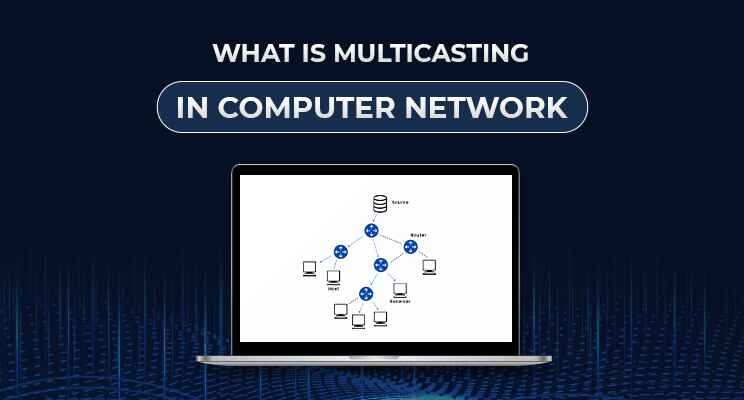Understanding Multicast in Computer Networks: Key Concepts and Use Cases
Understanding Multicast in Computer Networks: Fundamental Concepts and Applications
In contemporary networking, multicast in computer networks is an essential element of effective data delivery to multiple locations. In contrast to unicast or broadcast, multicast enables one-to-many or many-to-many data transmission without network flooding. Regardless of whether you are taking an SDWAN course, Cisco SD-WAN training, or studying for CCNP Enterprise training, knowing how to work with multicast routing in computer networks is critical. In this blog, we’ll explore what multicast is, how multicast routing works, where it’s used, and why it's crucial for network professionals.

What Is Multicast in Computer Networks?
Multicast in computer networks is defined as sending data from a single sender to a number of designated receivers. Instead of multicasting multiple unicast streams (one for every receiver), multicast sends a single stream to all targeted receivers. This method lowers bandwidth usage, reduces latency, and maximizes network efficiency.
Multicast comes in particularly handy in situations such as:
Live broadcasting of video
Web conferencing and online training
Distribution of software updates
Dissemination of financial trading data
Multicast Routing in Computer NetworksMulticast routing is the process that forwards multicast data across a network. It allows data packets to be delivered only to devices that have signaled interest in receiving them, and not to burden the whole network.
Multicast routing in computer networks makes use of dedicated protocols such as:
PIM (Protocol Independent Multicast): Often employed to construct multicast distribution trees.
IGMP (Internet Group Management Protocol): Employed by hosts and neighboring routers to discover multicast group memberships.
DVMRP (Distance Vector Multicast Routing Protocol): One of the first multicast routing protocols developed.
In our CCNP Enterprise training course and Cisco SD-WAN course at UniNets, hands-on labs and actual multicast routing examples are offered, providing students with real-world exposure to these protocols.
How Multicast Works in IP Networks
Multicast transmission is based on IP multicast addressing, using the address space 224.0.0.0 through 239.255.255.255. These addresses are reserved for multicast groups and help routers identify packets that require special handling.
Each device that wishes to receive multicast traffic subscribes to a multicast group. The router then forwards the multicast packets to only those links leading to interested receivers. This selective forwarding is where multicast routing proves to be efficient compared to conventional broadcast techniques.
The Role of IP Protocol Header in Multicast
In order to comprehend multicast completely, it's critical to be familiar with the IP protocol header structure, particularly the IPv4 header, as multicast packets ride in IP datagrams.
The internet protocol header contains important fields such as:
Version: Refers to the version of IP as IPv4 or IPv6.
Source IP Address and Destination IP Address: To make routing decisions.
Protocol: Identifies the next level protocol (e.g., TCP, UDP).
Time to Live (TTL): Restricts the life of the packet in order to prevent loops.
Within the multicast context, the destination IP address is multicast, allowing routers to forward it to only interested nodes. IPv4 header is hence centrally responsible for multicast packet identification and routing.
Multicast Applications in Enterprise Networks
Enterprise networks come to depend more and more on multicast for distribution of data, particularly in real-time applications. Practical applications include:
Video Conferencing: For enterprise communications and corporate webinars.
Financial Data Feeds: Provides real-time data to multiple terminals at one time.
Software Updates: Effectively pushes updates to big fleets of PCs.
IPTV Services: Employed by telecom service providers for content distribution.
Such networks should be taken care of by professionals opting for training in CCNP Enterprise at UniNets, where multicast technologies are handled in-depth.
Multicast in New-Age Architectures: SD-WAN and Palo Alto NetworksSD-WAN and Multicast
Conventional WAN designs usually find it challenging to handle multicast delivery efficiently with the limitations imposed by static routing. UniNets' SD-WAN training, however, prepares you to deploy multicast in cloud-first, dynamic environments.
SD-WAN training by Cisco involves multicast traffic management through overlay networks and application-aware routing. These features guarantee effective use of bandwidth across remote sites and branch offices.
Palo Alto Networks and Multicast Security
Security is a top priority when handling multicast traffic. Palo Alto Networks provides high-end firewall features that observe and manage multicast streams. At UniNets, in our Palo Alto course, we cover how to set up and secure multicast traffic with Palo Alto's next-generation firewalls
Joining a Palo Alto training program provides you with practical experience of actual multicast configurations and traffic observation. These are important skills for any network security engineer operating large-scale deployments.
Why Learn Multicast at UniNets?
At UniNets, we provide a series of industry-relevant networking courses that examine multicast technologies in-depth:
SD-WAN course for network engineers with an emphasis on WAN optimization and cloud integration.
Cisco SD-WAN training to become an expert in Cisco's Viptela or Meraki solutions.
CCNP Enterprise course for high-level routing, switching, and network design, and multicast.
Palo Alto courses that combine network security with real-time data processing such as multicast.
Each course is crafted by experienced individuals with real-world experience and comprises labs, certification guidance, and job support.
Conclusion
Multicast in computer networks is a very effective means to transmit data efficiently to numerous receivers. With knowledge of multicast routing, the format of the IP protocol header, and the IPv4 header, network professionals can create scalable, efficient, and secure systems.
Whether you are a prospective network engineer or are a cybersecurity professional, joining a CCNP Enterprise training, SD-WAN course, or Palo Alto training at UniNets will give you the expertise and confidence you need to apply multicast technologies to live networks.
